Seven Facts About Cavite City That You Should Know!
Cavite City will be celebrating its 82nd Charter anniversary tomorrow (September 7, 2022). As a pure-blood Caviteño, I guess this is also a perfect time to post something about the city I grew up with. While the city may not be as huge as other towns of Cavite such as Kawit, Imus, Dasma, Bacoor, or even Tagaytay, it was once the provincial capital of Cavite before it was formally transferred to Trece Martires City in 1956. Since Cavite City is a peninsula, it immediately prospered during the Spanish Colonial period when it became the main seaport of Manila hosting the Manila-Acapulco galleon trade. From being a small port town, it eventually grew as a municipality until it was officially founded as a town in 1614.
At the height of the Manila-Acapulco Galleon Trade, the Port of Cavite was the arrival and departure port of the Spanish galleons that brought many foreign travelers to its shores. The Port of Cavite was fondly called Ciudad de Oro Macizo meaning the “City of Solid Gold“. Control over the port was turned over to the Americans by Spain after the Treaty of Paris of 1898 at the turn of the 19th century. At the start of the American era, Cavite Puerto became the seat of the U.S. Naval Forces in the Philippines. It was redesigned to make way for modern ships and armaments. In September 7, 1940, the town was elevated to a charted city.
Today, I am listing down seven interesting facts about Cavite City!

The location of all the former 8 churches in Cavite City.
The City of Churches
Cavite City was once known as the city of churches. At some point, prior to the second world war, there were eight churches in Cavite city. Due to its geographic location, Cavite City became an ideal place for religious corporations. It became a strategic place next to galleons where friars could relax while awaiting the next voyage and attempt to convert and promote Christianism and also to engage in other businesses. Unfortunately, the second world war utterly damaged Cavite City which left most of the churches into ruins. These historic eight churches of Cavite City include the Parish of San Pedro Apostol, Parish of San Diego de Alcala, Parish of Nuestra Señora de los Remedios, Parish of Nuestra Señora de Loreto, Santa Monica Church, San Telmo Parish, Parish of San Juan de Dios, and the Parish dedicated to Nuestra Señora de la Soledad de Porta Vaga.

The Current location of San Pedro Apostol parish in Caridad
San Pedro Apostol Parish was establish between 1586 and 1591. The parish had the Immaculate Conception as its titular patron but was eventually dedicated under the patronage of Saint Peter the Apostle. The first church was originally located in San Pedro St in the old Port City of Cavite (the area is now called PN near the present Philippine Naval Base) but was completely destroyed after the massive aerial bombings. The current San Pedro Apostol Parish was built in 1984-1986 and was relocated to Caridad (Check: San Pedro Apostol Parish of Cavite City). San Diego Parish, on the other hand, was established by the Franciscans in 1591 along with a convent and a hospital. The church and the convent, however, were demolished in 1663. The parish dedicated to Nuestra Señora delos Remedios was built by the Augustinians in 1602 but was left abandoned in 1625 while Nuestra Señora de Loreto Parish was built by the Jesuits in 1615 until 1768 when Jesuits left the country by the order of King Charles III of Spain.

The remaining ruin of Santa Monica Parish in Cavite City
The Parish of Santa Monica was established in 1616 by the Recollects. Out of all the churches in Cavite City, only the ruins of Santa Monica can still be seen today after the Second world war impact. The San Pedro Telmo Parish, on the other hand, was established by the Dominicans in 1619 and it was made into a shrine in 1752. Unfortunately, the church was one of those that was utterly destroyed during the World war II. San Juan De Dios Parish was built in 1641 along with a hospital. The ermita or shrine of Our Lady of Solitude was first built in 1692 and was reconstructed in 1765. It enshrines the miraculous image of Our Lady of Solitude. Today, a historical marker and a scaled replica of the church can be seen in its original site.
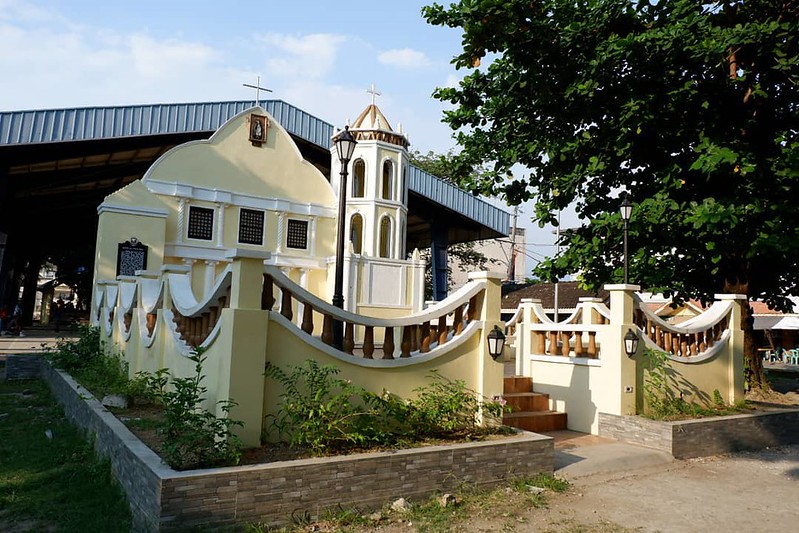
Historical marker and scaled replica of Ermita de Porta Vaga
Chavacano: A Dialect that Must be Saved
Chavacano is a Spanish-based creole language that was formerly spoken by the majority of people living in Cavite City. The origin of Chavacano can be traced back during the arrival of Spaniards and Mexicans in the 16th century. During this period, the people that lived near the military arsenal in Cavite City put themselves in contact with the Spaniards and Mexicans and began to incorporate in their own dialect many Spanish words. Cavite City is one of the few places in the country that uses this creole language. It is more prominently used in Zamboanga. Unlike in Zamboanga, however, Chavacano de Cavite is notably much closer to Spanish in terms of grammar. Ternate is also another town in the province of Cavite that uses Chavacano dialect but is considered to be a different variant as it is written and spoken in different manner.

Reina de Cavite Hymn written in Chavacano
Chavacano was used by many poets and composers who were raised in Cavite City. Jesus “Batikuling” Balmori, a renowned Filipino Poet expressed his admiration to Chavacano and wrote poems written in such dialect. Cavite City native Julian Felipe who composed the Philippine National Anthem also composed music for songs that are entirely written in Chavacano including the “Reina de Cavite” (1892). The hymn was based on the poem written by Padre Tomas de Andrade in 1689. While Chavacano still exists in Cavite City, only few people are using it today and most of which are elderlies. Unfortunately, the dialect is slowly dying. Interestingly, the government and other NGOs are still making efforts to save the dying language and introduce it to newer generation of Caviteños.
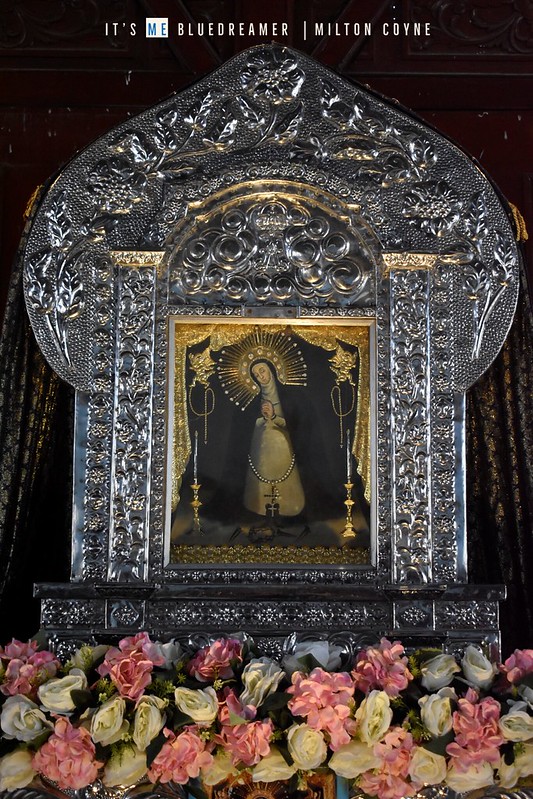
Replica image of Our Lady of Solitude of Porta Vaga
Our Lady of Porta Vaga, An Undying Devotion and a National Cultural Treasure
Our Lady of Porta Vaga is not just the patroness of Cavite City but of all the provinces in Cavite, hence the title “Reina De Cavite” (Queen of Cavite). It is one of the well known Marian devotions in the country. Our Lady of Solitude of Porta Vaga is also considered as the oldest extant dated Marian painting in the Philippines. According to local legend, on one stormy night, a Spanish soldier saw a halo of bright light amongst storm clouds above Canacao Bay. Thinking the light to be coming from Islamic pirates intent on sacking Cavite, the sentry shouted a challenge to the lights as they approached him. When the light did not stop, he again called out. A calm and soothing voice replied from the light: “Soldier boy, why challenge me on a night so cold? Let me pass. Don’t you recognize Mary?” The soldier replied: “Forgive me, my Virgin, Queen of my heart; for I am a poor sentinel abiding by his duty.”
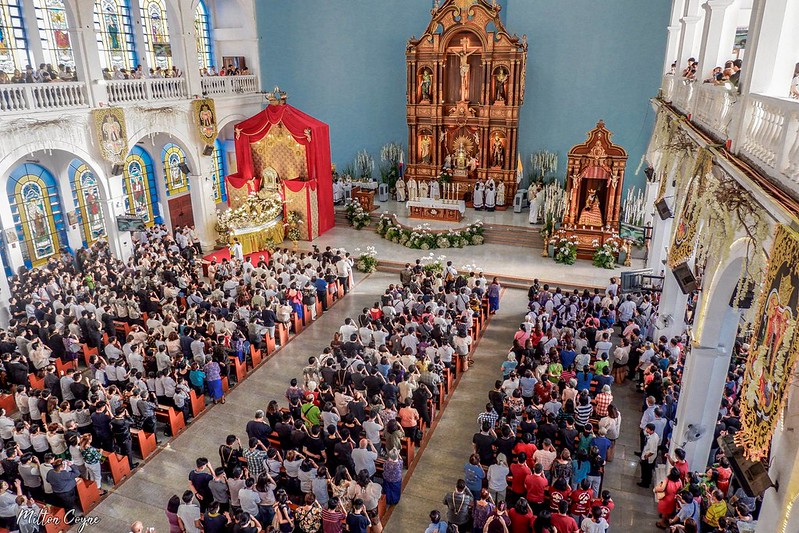
Devotees of “Nana Choleng” during her Canonical Coronation
The Following morning, the fishermen found a framed image of the Virgen de la Soledad lying on the sandy shore, the same site where the Virgin Mary appeared. They brought the image to the parish priest, who temporarily installed it in the parish church. Later, a small chapel was built near the Porta Vaga walls and for three centuries it became the shrine of the Virgen de la Soledad. Since then, numerous miracles were attributed to the image. Today, the original painting is enshrined to San Roque Parish which was recently elevated to Diocesan Shrine of Our Lady of Solitude of Porta Vaga. Also in 2018, the painting of Our Lady of Porta Vaga was officially declared by the government as a National Cultural Treasure of the country. The devotion to the image is continuously growing. Traditionally, the feast comes with two-week long celebration covering the 2nd and 3rd Sunday of November.

The original image of Our Lady of Porta Vaga enshrined on her permanent chapel in San Roque Parish Church
Cavite City’s Unique Cuisine
Cavite City is among the main traiding centers in Cavite. The cuisine is primarily influenced by ingredients that are available locally or through trade. The City is known for some unique dishes and delicacies. This include the popular “Bacalao“, a dish that is traditionally served during Lenten season. It is a dish made of dried cod fish, potatoes, garbanzos, cabbage, and bell pepper. This is often matched with another Lent beverage known as ‘Chin Chao“, a refreshing drink that includes brown tikoy cubes, noodle-like ingredient made from rice and glutinous flour, gulaman, sago, shaved ice and arnibal (brown sugar syrup)

Bacalao of Cavite City

Chicken Pipian
Other unique dishes from Cavite City includes Calandracas, a soup that is traditionally served during Christmas or New Year’s Eve; Chicken Pipian, a variant of Kare-kare; Pancit Pusit, a noodle dish cooked in squid ink (resulting to black color); Pancit Puso, another noodle dish often topped with banana heart soaked in sour vinegar sauce. Tamales is also another distinct delicacy from Cavite city made from ground peanut and rice. We also have Quesillo, a cheese variant made from carabao’s milk and Bibinkoy, a sticky rice dessert made from glutinous rice topped with ginataan (coconut milk) sauce. Pat & Sam’s Malagkit (cassava cake) is also another noteworthy delicacy popular in Cavite City.

Regada Water Festival
Regada Water Festival
Regada Water Festival is one of the highly anticipated festivals in Cavite City. Regada is a traditional water festival celebrated annually every 24th of June to honor the feast day of Saint John The Baptist. Regada Water Festival is special in its own right and offers a bunch of activities for Caviteños to enjoy. The festival started in 1996 during the term of the late mayor Tim Encarnacion and since then, it has become one of the most festive events traditionally celebrated in Cavite City. The term Regada came from the Spanish word “Regar” which means to pour, to water, or to sprinkle. The highlight of the festival is the so-called “Basayawan” where people splash water on anyone whether they are strangers or not. What really makes this celebration a lot more fun and special is the long sprinkler installation that stretches more than a kilometer long along P. Burgos Avenue. The sprinklers will be activated from time to time in the entire course of the celebration and are wonderfully matched with the sound systems, concerts, and a great number of fun activities that literally transform P Burgos Avenue into a huge wet party. (Check: 7 Things About Regada Festival)
Firetrucks can also be spotted in the event not to put out fires but to splash water on everyone on the street. One thing is for sure, this annual festival is definitely not for cranky people. Whatever you are wearing, wherever you are going and even if you are in a vehicle, expect that people are equipped with a water gun or are carrying a pail of water and you must prepare yourself to get wet!
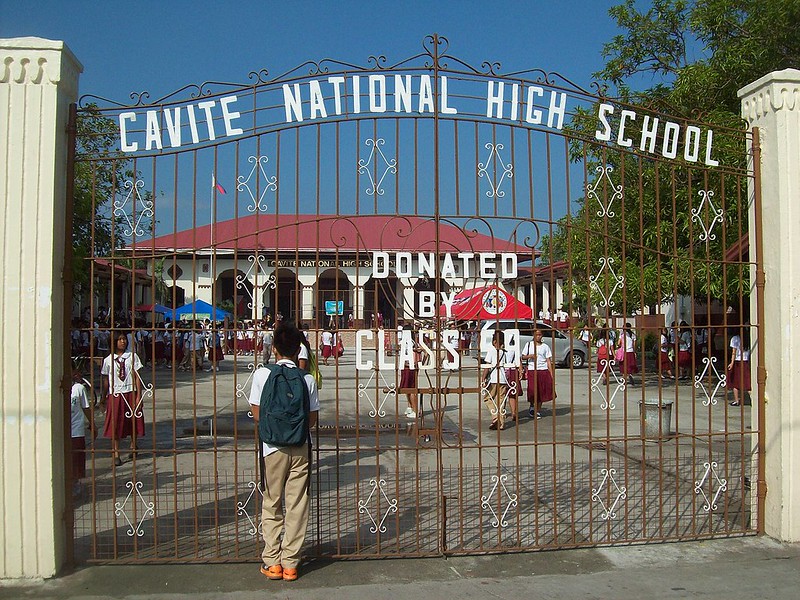
Cavite National High School (Image from Wikipedia)
Cavite National High School
Did you know that Cavite City is also the home of one of the oldest national secondary schools in the country? Cavite National High School was established on June 19, 1902. The first campus was located at the Isthmus of Rosario, in the town of San Roque where Garita Elementary School now stands. Hon. Mariano Trias, then Governor of Cavite, suggested that a High School be established in Cavite, San Roque or Caridad. When it first started, there were only 25 students. However, the first building was in a bad shape and considered unsanitary so the principal decided to raise fund to repair it. The school became operational the following month. In 1903, Cavite High School transferred to an old but spacious disputed government land where a Spanish hospital stands. Student population continued to increase and during the same year, a debating society was organized among the advanced students. Also, in 1904 and in 1905 respectively, a baseball team and a track and field team was established. The Supreme Court however ordered that the land be returned to the Catholic Church. Again, the school had to relocate at P. Gomez st. where the Spanish Provincial Governor used to reside.
In 1908, the High School saw its first five graduates, four males and one female. In 1928, the school had to move to Caridad Preparatory before transferring to its present lot, a sprawling 6-hectare lot located donated by Caridad Estate of Cavite, Inc. through Mr. Hammond Buck who was engaged in the Bureau of Education prior to being engaged in real estate. In 1963, it was converted into a National High School. The school admits more than 1,500 new freshmen students from elementary schools in the city as well as in neighboring towns. The present student population is almost 7,000.
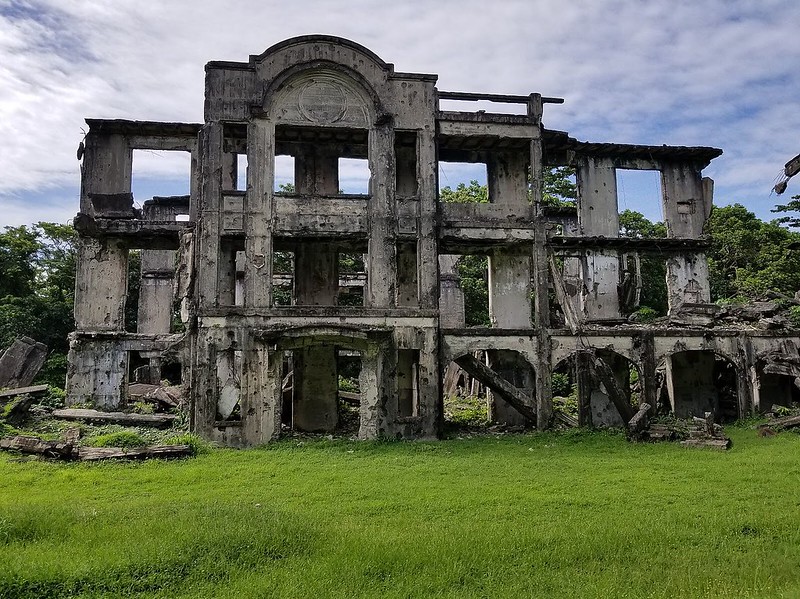
Ruins in Corregidor Island
Corregidor Island
Little did everyone know, Corregidor Island is part of Cavite City. During World War II, Corregidor played an important role during the invasion and liberation of the Philippines from the Imperial Japanese Army. The island was heavily bombarded during the later part of the war, where the ruins serve as a military memorial to American, Filipino, and Japanese soldiers who served and lost their lives on the battlefield. Corregidor is one of the most important historic and tourist sites in the country.
Despite being located nearer to the southern coast of Bataan, Corregidor and the other fortified islands of Manila Bay fall under the jurisdiction of Cavite City. Under Spanish rule, Corregidor served not only as a fortress of defense, a penal institution, and a station for customs inspection, but also as a signal outpost to warn Manila of the approach of hostile ships. The tunnel system under Malinta Hill was the most extensive construction on Corregidor. It contained a main east–west passage 826 ft (252 m) long with a 24 ft (7.3 m) diameter, in addition to 25 lateral passages, each about 400 ft (120 m) long, which branched out at regular intervals from each side of the main passage. A separate system of tunnels north of this housed the underground hospital.
The defensive arsenal on Corregidor was formidable with 45 coastal guns and mortars organized into 23 batteries, some seventy-two anti-aircraft weapons assigned to thirteen batteries and a minefield of approximately 35 groups of controlled mines. After the fall of Bataan, the Corregidor Island served as one of the last allied stongholds in the Philippines. Constant aerial bombardment attacks by the Japanese ate away at the American and Filipino defenders. General Jonathan Wainwright, commander of the U.S. Armed Forces in the Philippines, offered to surrender Corregidor to Japanese General Masaharu Homma. Corregidor’s defeat marked the fall of the Philippines and Asia. Prior to pandemic, Corregidor Island can be reached via the Sun Cruise in SM MOA. The new government of Cavite City is also planning to include Corregidor Island as part of its tourism campaign in the near future.
Here are other Cavite City Related Articles you might want to read
- Live Via Crucis of Cavite City
- Ati-Atihan and Stree Dancing and Exhibition in Cavite City
- Bangenge Festival
- Canonical Coronation of Our Lady of Solitude of Porta Vaga
- Feast of the Black Nazarene in Cavite City
- Churches and Chapels in Cavite City to Visit during Holy Week
Data References: Angel Fire / Bien Chabacano / JSTOR / Asomf.Org / Lutong Cavite / IYIL.ph /Cavite National High School


Pingback: Revisiting the 46th Live Via Crucis in Cavite City - It's Me Bluedreamer!